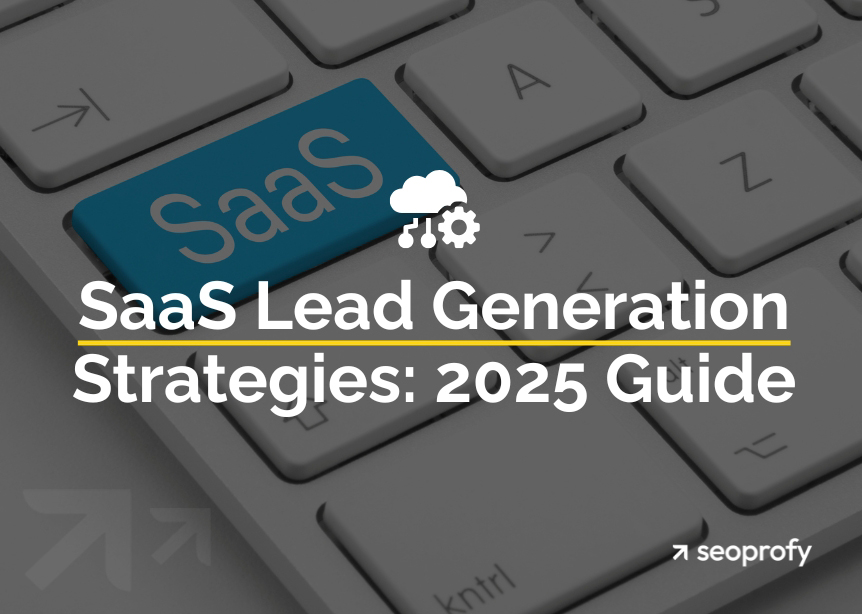SaaS keyword research shapes how potential clients find your product. And this process is not always linear. The right strategy will help you meet them where they are and guide them naturally toward your product.
The problem with keyword research for SaaS is that most teams go straight to SEO tools. Although their data is beneficial, some of the best insights aren’t in search volume reports. They’re in your sales calls, customer support tickets, subreddits, and competitor research.
We’ll talk about this and more in today’s comprehensive guide to SaaS keyword research. You’ll learn twelve useful strategies to find valuable keyword ideas for your campaigns, as well as helpful tips along the way.
- Targeting a variety of keywords that cover all search intents works best for SaaS as they guide users from awareness to decision.
- Sales and support teams know your customers and their pain points best, so talking to them can give you many helpful keyword ideas.
- Google’s Autosuggest and People Also Ask are some of the underutilized ways to find long-tail queries for SaaS keyword strategy.
- Grouping your keywords into clusters can help you build topical authority with search engines and also strengthen E-E-A-T signals.
What Is SaaS Keyword Research?
Keyword research for SaaS is a process of finding the words and phrases your target audience types into Google when looking for software like yours. It helps marketers create relevant and optimized content that attracts high-intent traffic, improves customer retention, and ultimately drives SaaS business growth.
Everyone on the team can contribute to this process. SEO specialists are usually in charge, but sales and support teams have useful insights, too. They hear directly from customers about what they need, which helps create content that speaks directly to them.
If we compare it to traditional SEO, which often focuses on high-traffic, broad keywords, SaaS SEO prioritizes more specific, long-tail queries that are related to the software and the problems it solves. We’ll talk more about this in later sections.
Why Is Keyword Research Important for the Growth of a SaaS Business?
Keyword research is the foundation of everything in SaaS SEO strategy. It’s what brings your target audience to your site and helps you attract more organic traffic and sales over time.
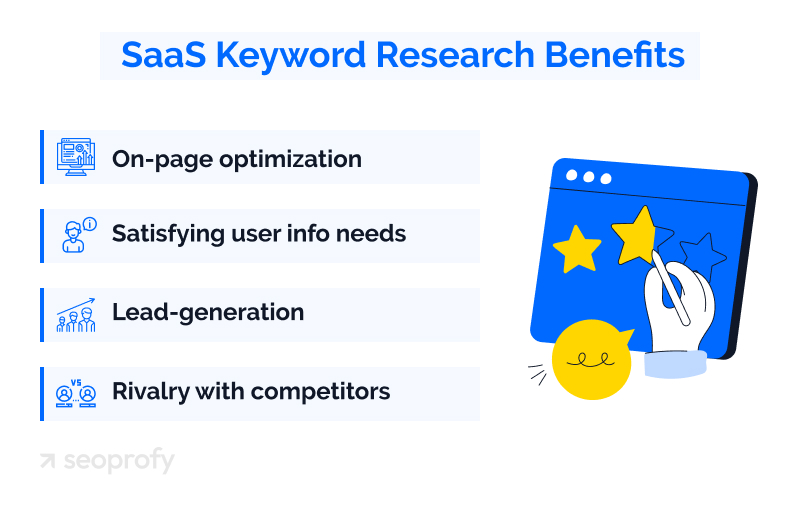
Here are some other reasons why this step is an important part of every marketing campaign:
- It sets the foundation for your on-page optimization and site structure.
- It helps you map out a content plan that answers specific user needs at each stage of the buyer’s journey.
- It lets you find high-intent queries, which can help improve your lead-generation efforts.
- It allows you to identify any gaps between your and your competitor’s content and use the findings to strengthen your strategy.
All big SaaS brands take keyword research seriously. And for good reason — 60% of marketers say SEO and blog content bring in better leads than any other strategy. If we look at HubSpot’s blog, it generates millions of searches because it ranks for queries that marketers and sales teams actively look up.
The same goes for other companies like Notion or Asana. They target a broad range of keywords that are relevant to their target audience and create content that helps turn that traffic into signups. Now that you see the impact keywords have on your business, let’s check how you can find them.
12 Strategies for Effective SaaS Keyword Research
There’s more than one way to pinpoint relevant terms for your campaigns, and below, we’ll share with you some of the best saas keyword research methods:
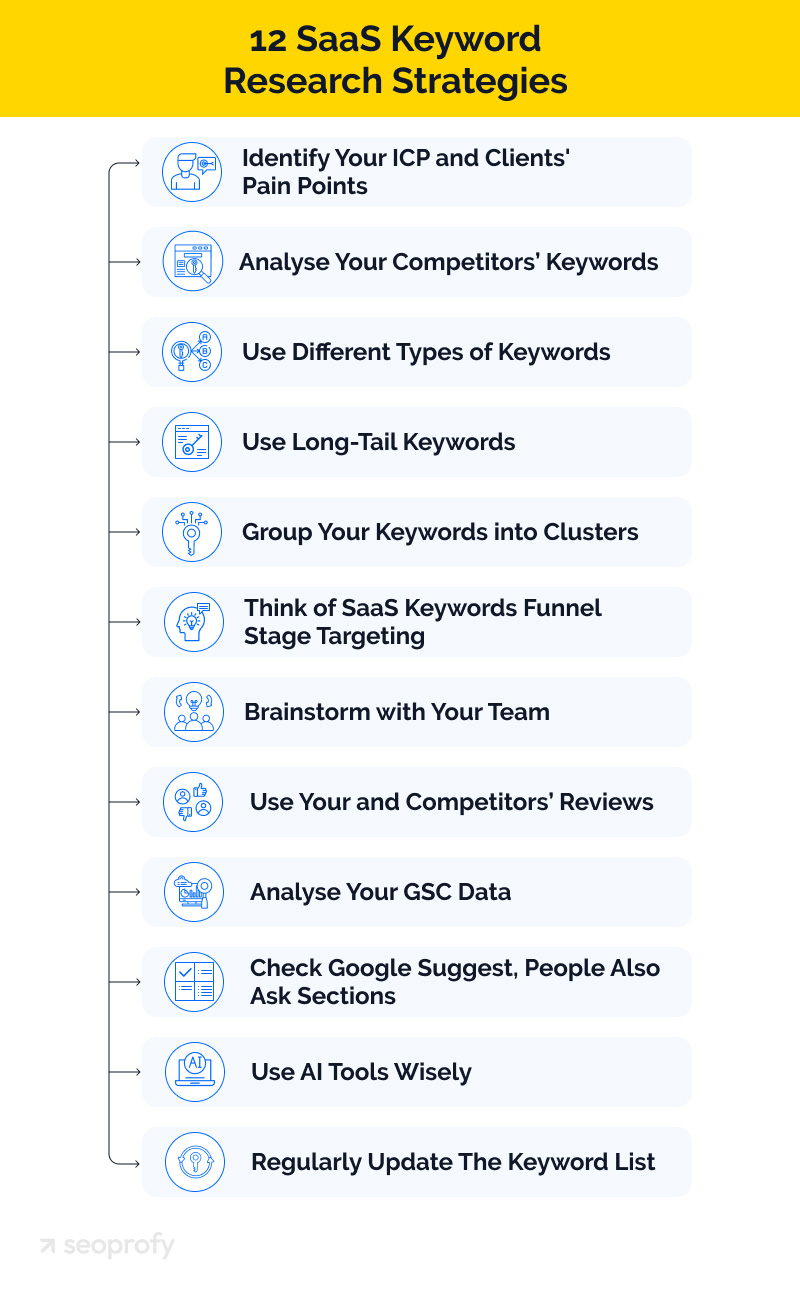
1. Identify Your ICP and Clients’ Pain Points
Strategic keyword research and any effective marketing for SaaS always starts with the audience. That’s because not every person is a good fit for your SaaS product and your goal is to only attract people who actually need it.
Many companies create an Ideal Customer Profile (ICP) or a buyer persona, where they write down things like job roles, company size, industry, goals, and how their product fits into the customer’s day-to-day work. If you don’t have a buyer persona yet, the questions below can help you create it for your SaaS keyword research:
- What roles or job titles usually use or buy your product?
- What type of companies do they work at (size, industry)?
- What problems are they trying to solve with a tool like yours?
You can also check places like LinkedIn or Reddit to learn more about your client’s pain points. People share their thoughts online all the time, and those insights can help you understand what content you need to create. It’s a good idea to make a simple spreadsheet and list all your findings there.
This kind of audience research isn’t something you do once. You’ll need to keep an eye out for new pain points and regularly communicate with your customers to update your spreadsheet.
Once you have a clear picture of your customers, keyword research gets a whole lot easier. You’ll know exactly what problems they’re trying to solve and what terms you need to target in your content to support your overall SEO goals. We’ll go even deeper into this in a later section, but for now, let’s look at our next strategy.
2. Analyse Your Competitors’ Keywords
Keyword competitive analysis can tell you a lot about what’s working in your industry. If a company with a similar product is ranking well on Google, chances are they’ve already done some of the hard work in finding the right keywords. That doesn’t mean you should copy them, but analyzing their pages can give you ideas for your SaaS keyword research and help you notice any gaps in your strategy.
To start your analysis, you’ll first need to have a list of competitors that sell similar products to yours. You can find this data with the help of keyword research tools. Some of the best options are Ahrefs, Semrush, SE Ranking, and Keywords Everywhere.
If the SEO software of your choice is Ahrefs, simply enter your website URL into Site Explorer and go to the Organic Competitors tab. The tool will list all the websites that rank for keywords similar to yours.
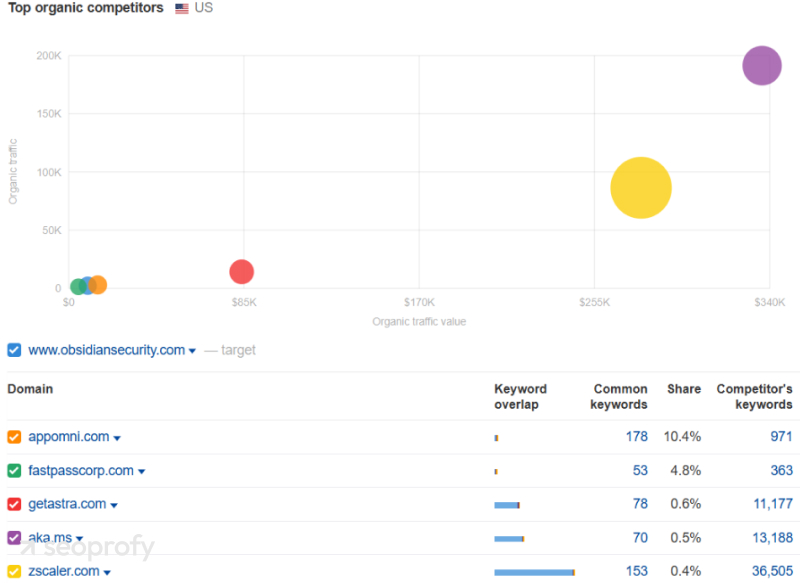
You can then type the URLs of your competitors one by one and check the organic keyword reports. By default, Ahrefs will show you the terms that are driving the most traffic to their sites. To further sort the results, use filters like KD (keyword difficulty), search volume, or position.
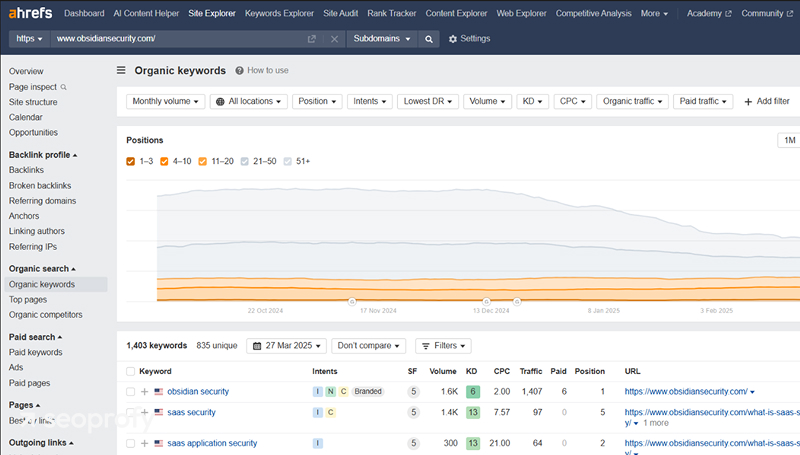
As good as this strategy sounds, avoid the mistake of copying all the keywords of your competitors. Just because they rank for them doesn’t always mean they’ll be a good fit for your strategy.
Your competitors have a different DR (domain rating) and might be way ahead of you when it comes to authority and backlinks. If your site is newer, you’ll have to work much harder to outrank them for the same terms.
So, what can you do instead? Look for terms with relatively low KD scores and try to add more value to your content than your competitors. This way, you’ll be able to rank for relevant keywords and slowly build your authority in the field.
If competitor research feels like too much to handle in-house, you can always delegate it to an outsource SEO team that specializes in it. It’s a common practice for SaaS companies that want to save time and tap into expert skills.
3. Use Different Types of Keywords
People turn to Google for all sorts of reasons, and understanding the search intent behind their searches can help you create content that matches their needs. There are four main types of search intent you need to know about when developing an SEO strategy.
- Informational intent: As the name suggests, these users are looking to learn more information on the topic. They might type something like, “What is project management software?” or “How to choose a CRM?”
- Navigational intent: Here, people already have a destination in mind. They’re looking for a specific brand, login page, or pricing details, like “Asana pricing page.”
- Commercial intent: Users at this stage are weighing their options and are closer to making a decision. They’re reading comparisons, reviews, and best-of lists, such as “Best project management software.”
- Transactional intent: These are the most profitable keywords. The user knows what they want and is ready to buy. They type in queries that include words like “buy” or “purchase”, for example, “Buy Asana subscription”.
Many SaaS companies zero in on transactional keywords, since they drive the most revenue. But according to a recent SparkToro survey, they make up less than 1% of all searches.
So, a better approach for your SaaS keyword research is to cover all types of search intent. This will help you build authority with search engines and improve your SEO ROI over time by attracting and nurturing leads across the full keyword funnel.
At SeoProfy, we’ve worked with multiple SaaS businesses for the past 12 years and helped them achieve higher rankings and attract more clients. If you’d like to see similar results, schedule a free consultation today and we’ll design a custom SEO strategy that gets you:
- More visibility in search results
- More high-quality traffic
- More leads and conversions

4. Use Long-Tail Keywords
Long-tail queries that contain more than three words can be highly valuable for SaaS businesses. They are more specific, less competitive, and often show a commercial intent.
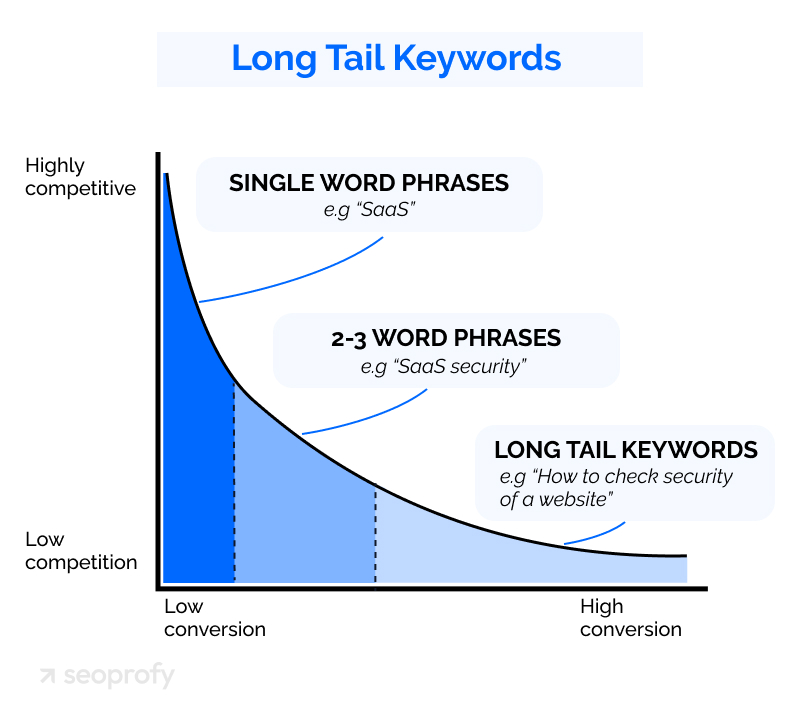
To explain why they matter for your SaaS keyword research, let’s first review the keyword metrics that impact your rankings.
Keyword Difficulty
Keyword Difficulty (KD) estimates how easy or hard it is to rank for a certain term. Here’s how you can look at it:
- 0-10 KD – Very easy
- 11-30 KD – Easy
- 31-50 KD – Medium
- 51-70 KD – Hard
- 71-100 KD – Very hard
For newer sites that don’t have much authority yet, it’s a good idea to focus on keywords with low to medium difficulty. Of course, some of the most valuable terms you’d want to rank for will have high competition. A good example is something like a “employee engagement tool,” which has a KD of 39.
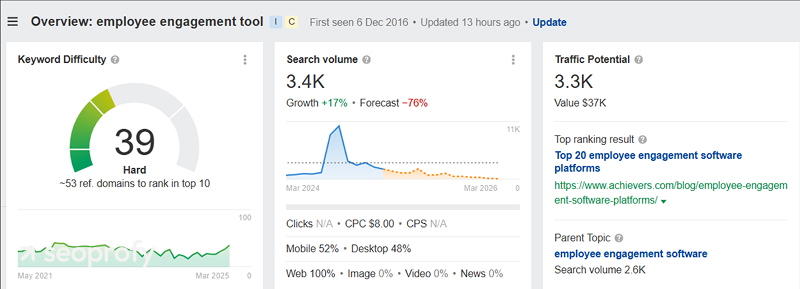
If ranking for that kind of term isn’t realistic right now, you can always run paid search ads to get in front of your audience. Ads show up at the top of the results page, so they give you a way to stay visible and drive traffic while you’re building up your rankings through easier keywords.
Search Volume
The monthly search volume tells you how many people look up a keyword each month in a certain country. Although it’s common practice to aim for terms with decent traffic potential in your SaaS keyword research, some of the best keywords you’ll find only get 100 to 500 searches a month.
For example, “best project management software for small businesses” won’t get as many searches as “project management software”. Still, it can be highly relevant for your business and might draw in valuable leads.
Domain Rating
Domain Rating (DR) is an Ahrefs metric, which measures how strong a site’s backlink profile is. It’s not a direct ranking factor but Google often sees sites with higher DR as more authoritative.
If your Domain Rating (DR) is low, it’ll be hard for you to go after broad and competitive keywords. You’ll first need to grow your backlink profile and build trust with search engines. A good first step to achieve it is to categorize your terms and build a content strategy around related topics.
5. Group Your Keywords into Clusters
Google looks at how comprehensively you cover a topic and checks E-E-A-T (expertise, experience, authority, trustworthiness) signals when ranking websites. To show that you are an expert in your niche, you need to look at keywords not individually but as a group and cluster them thematically.
One of the most useful SaaS keyword research tips is to work through clusters one at a time. You first build your content around one group and then repeat this process for the other clusters.
This way, you are slowly growing topical authority in your niche and also avoiding keyword cannibalization, which happens when too many pages on your site compete for the same search terms. If we look at Stripe, a SaaS payment software, their blog is divided into four separate categories:
- Corporate: News about the company, growth, and strategy
- Engineering: Technical articles written by their developers
- Industry: Articles about trends and changes in the payments industry
- Product: Guides on how to use Stripe’s tools
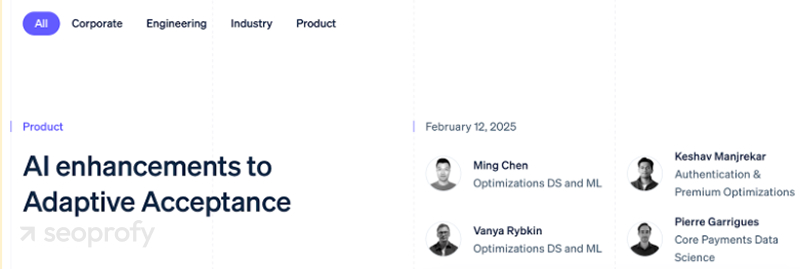
This structure works well for them because Google can see that the content is well-organized and explores different angles of their service. It also strengthens E-E-A-T signals and improves rankings.
We’ve used this exact approach in our projects as well and were able to grow a client’s organic traffic from 22,000 to 68,000 monthly visitors. You can read more about it in this SaaS case study.
Not only do search engines favor this approach, but your users will find it helpful, too. When everything related to a topic is in one place, people stay on the site longer, engage more, and see the company as a reliable source. The longer you stick to this method in your SaaS keyword research strategy, the easier it gets to rank for more competitive searches.
6. Think of SaaS Keywords Funnel Stage Targeting
In SaaS, the buying process isn’t quick. People usually take their time to read guides, compare tools, check reviews, and talk to their team before making a decision.
This means your search engine optimization strategy should meet them where they are and help guide them naturally through the buying funnel. A customer journey map can help with this.
It shows how someone goes from realizing they have a problem to eventually choosing a solution. To make this more practical, let’s break down each stage of the funnel below.
Top of the Funnel (TOFU) — Awareness Stage
At this stage, people aren’t looking for a product yet. They only start to understand that they have a problem and want to learn more about it. These keywords tend to be broad and educational, for example:
- What’s a [SaaS product]?
- How to use a [SaaS product]?
- A beginner’s guide to [SaaS product]
Since users are in learning mode, your content should help them understand the topic without pushing a sale. Blog posts, industry reports, explainer videos, and beginner’s guides work well here.
For example, Asana, a B2B SaaS company, has blog posts like “What is Agile Methodology?” This type of content educates people who might not be ready to buy now but could become SQLs down the line.
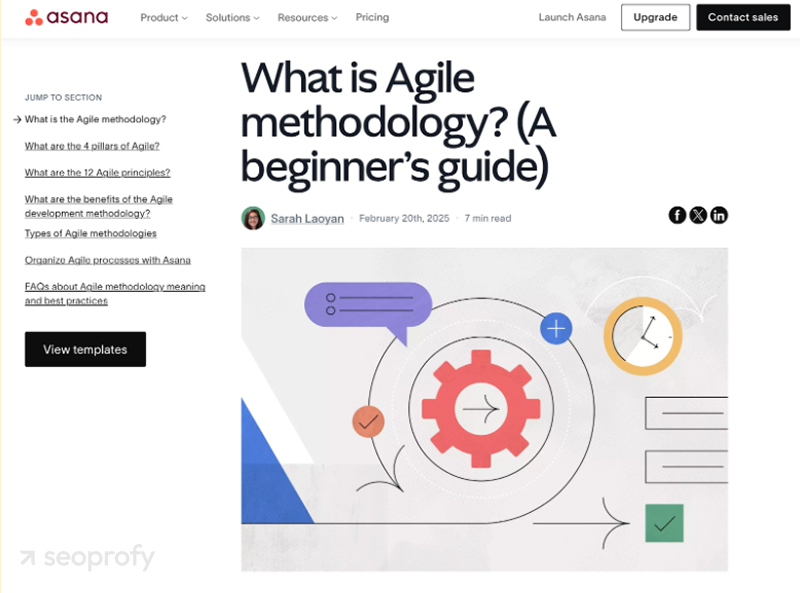
Middle of the Funnel (MOFU) — Consideration Stage
After learning more about their problem, people start to look for solutions. They’re comparing products, checking reviews, and figuring out what might work for them or their team. Keywords become more specific, as we can see in the examples below:
- Best [SaaS product] for [industry]
- [SaaS product] vs [SaaS product]
- Top [SaaS product] for [industry]
For this stage, content formats like comparison guides, case studies, webinars, and product demos work best. You basically want to help people weigh their options and show how your product differentiates from the rest.
Zendesk, for example, has a listicle where they compare the best CRMs for small businesses. Naturally, their own tool is on the list and they also offer a free demo on the page.
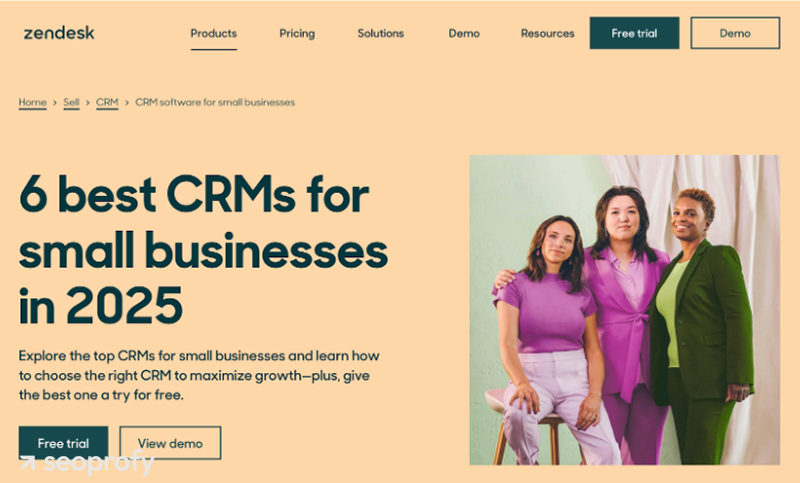
Bottom of the Funnel (BOFU) — Decision Stage
At this point, users know what they want. They are using funnel keywords like “buy” or “free trial”. and need some final validation before purchasing. The queries at this stage often look like these:
- [SaaS Product] pricing
- Buy [SaaS product]
- Sign up for [SaaS product] free trial
As for the content formats, landing and pricing pages work best for BOFU. Notion, for example, has a pricing page that lays out what each plan includes, who it’s best for, and how much it costs.
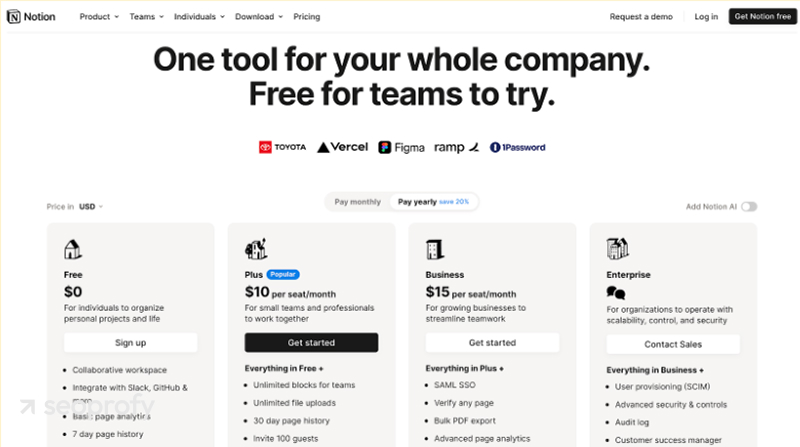
We can see from the examples above that the best SaaS companies structure their content around different points in the buying process. And when everything lines up, potential customers find exactly what they need and are more likely to convert over time.
7. Brainstorm with Your Team
Among all the SaaS keyword research tactics out there, talking to your sales and support teams is one that’s often overlooked. Yet, it’s one of the easiest ways to find valuable keyword ideas. Your sales and customer support teams talk to customers every day.
They hear the same pain points, questions, and concerns over and over again. That’s exactly the kind of language you want to use in your keyword strategies.
You can schedule a meeting with a few salespeople and have them walk you through real conversations they’ve had recently. What problems come up the most? What specific words do customers use when describing them?
Do the same with customer support. Review support tickets and look at how issues are tagged and categorized. If you have recorded customer interviews, check them too.
As you go, write down a list of exact phrases and questions that come up often. Once you have a list, take each question to Ahrefs or any other keyword tool to see if there’s potential. You can also look at variations to see if any related terms can be used.
8. Use Your and Competitors’ Reviews
Customer reviews, both yours and competitors’, can also be helpful for your SaaS keyword research process. Sites like G2, Capterra, and GetApp, as well as forums like Quora and Reddit, are some of the best places to find them.
People use these platforms to share what they like and, more importantly, what they dislike about the product. Since they’re writing in their own words, you also get a good perspective on what kind of language your target audience is using.
You can go through the review titles and skim the comments. Then, follow the same approach as in the previous strategy. Write down any keywords or topics that come up again and again. After that, put them into your SEO tool and check the keyword data for each to see if they are worth pursuing.
9. Analyse Your GSC Data
Although Google Search Console won’t help you find new keywords, you can still use it to understand what terms you’re already ranking for and improve their position in SERP even more.
Inside the GSC, you can click on Search Results to see a list of queries your site appears for in Google. You’ll also get data on clicks, impressions, and your keyword positions. A good place to start is to sort CTR from lowest to highest.
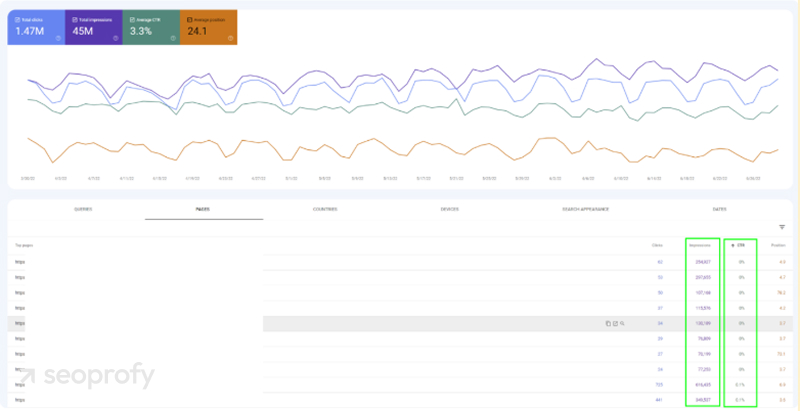
This will show pages that don’t get clicked on often in the search results. It might be time to improve your titles, meta descriptions, or how relevant the page is to that query.
To take a closer look at the keywords your other pages are already ranking for, click New and choose Page from the dropdown menu. Then, enter the URL, and you’ll see all the search queries that are driving traffic to that page.
Filter by position and take note of the ones that are ranking in positions 7-20. Some of these words will naturally fit into existing content as secondary keywords. If a keyword seems important but doesn’t quite fit, it might be worth creating a separate page for it to rank better.
To speed things up, you can filter the results with the help of regex (regular expressions). It lets you pull out specific types of queries faster. If you want to see all the questions your site ranks for, try this pattern:
(?i)^(who|what|where|when|why|how)
This pulls up searches that start with words like “how,” “why,” and “what,” which show common customer questions. You could also leverage regex to filter out branded search keywords in case you only want to see non-branded searches.
10. Check Google Suggest, People Also Ask Sections
Another underutilized SaaS keyword research methodology is Google’s autocomplete and People Also Ask. They show similar terms people are searching for, which helps you find long-tail phrases that might not be immediately obvious.
All you need to do is type in your main keywords into Google’s search bar and look at the ideas it gives you. For example, if we input “best CRM”, we’ll see the following suggestions:
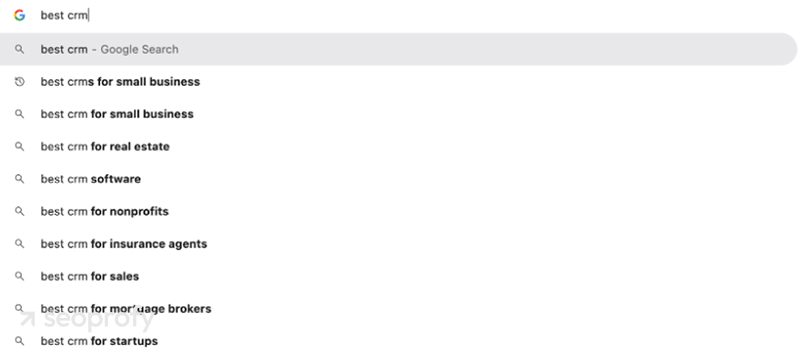
Some of these queries might not be relevant, but others could be worth adding to your keyword list. If one looks useful, search for it and check the new suggestions that appear. This way, you can expand your list with related terms.
Similar to the autosuggest feature, you can check the PAA section in the search results for each of your target keywords. These are the common questions people ask online.
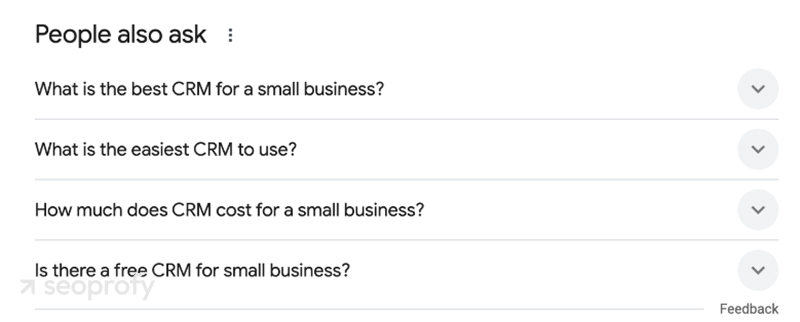
If relevant, you can cover them in your content and FAQ section. Since Google shows them to users, it means that there’s a clear demand for these questions. You can expand each of these questions further and find an even bigger pool of relevant questions and topics for your content.
11. Use AI Tools Wisely
There are plenty of AI SEO tools out there that can help you with SaaS keyword research and content planning. One that’s worth looking into is Google AI Overview Impact Analysis.
It lets you check whether any of your keywords trigger an AI Overview in Google’s search results. This helps you decide which keywords to focus on and how to create content that complements these summaries.
Additionally, you can use ChatGPT or Claude to mine customer pain points based on the list you put together from reviews and conversations with your team. These LLMs can quickly sort the feedback into themes and spot patterns. Once you see what comes up the most, it’s easier to figure out which keywords are worth exploring.
Still, no matter the tasks you’re using AI for, don’t forget to double-check the output and always rely on your own judgment. These tools can hallucinate and don’t always have the most up-to-date information. But if used wisely, they can do the repetitive tasks for you and allow you to work more efficiently.
12. Regularly Update The Keyword List
As with anything in SEO, SaaS keyword research is not something you do just once. It should be revisited regularly as part of your brand-building, SaaS marketing strategy, and ongoing promotion efforts.
The reason for this is that search algorithms change all the time and your competitors aren’t standing still either. Your product will also add new features or maybe you’ll decide to target a new segment.
All of that impacts the keywords you target and how you measure SEO performance over time. When you revisit your data, here’s what’s worth paying attention to:
- Look at what you’re ranking for now and what new terms are showing up in Google Search Console
- Check underperforming pages and see if any keyword needs to be changed or added
- Review what your competitors are targeting and what new keywords work for them
You don’t need to overhaul your keywords weekly, but once a quarter is a good rhythm, or more often if you’re in a fast-moving space. This will help you stay up-to-date and keep your pages performing well.
Summary
If you’ve made it this far, you can already see that keyword research is a part of SEO that touches everything. It affects the content you produce, the pages you develop, and the visitors you attract. Done well, it helps you create a path between what your product offers and what your customers are searching for.
Although we mentioned many strategies on how to do keyword research for SaaS, you do not need to follow each of them at once. Use what fits your business and test the ones that seem the most relevant. Working with keywords is an ongoing work but eventually, it pays off with more traffic, better leads, and more signups.
In case you need support from a team that does this every day, reach out to our SaaS SEO agency, SeoProfy. We build strategies grounded in data and search behavior so you can get more out of the work you’re already putting into SEO.








